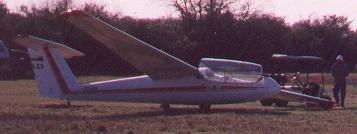Dylan's Flying Page
WHEN
: Sunday 19th March 2000
WHAT
: What's a Blanik like upside down? Intro to the L-23
WHO
: Dual instruction with Barry Dunning
HOW LONG : 39 minutes in 2 flight
 Today was a rather exciting session for several reasons!
Firstly, a cold front had just come through. We had one of those bright,
crisp, blue sky days. However, this isn't without its penalty - in this
case, winds in excess of 15 knots, gusting to 25 knots!
Today was a rather exciting session for several reasons!
Firstly, a cold front had just come through. We had one of those bright,
crisp, blue sky days. However, this isn't without its penalty - in this
case, winds in excess of 15 knots, gusting to 25 knots!
The Schweizer was left in the hangar. It sits tail low on
the ground, and with the winds that we were getting, it would just get
blown over. So, today I would try out the Blanik. It would also mean
that I wouldn't get to solo (we still have to do the simulated rope break,
and with that much wind, landing downwind isn't safe).
I knew it would be interesting on tow. It was pretty turbulent
on the flight up to the glider field - and it wasn't all lift. I could
feel humungous areas of sink even in the Cessna 140 (including a couple of
zero-G jolts that had my headset and camera bags jump off the seat!)
To add to this, the Blanik is much more responsive than the 2-33. Actually,
I think that helped.
It had calmed down a bit turbulence-wise by the time I got
to fly. I fell in love with the Blanik straigt away. The L-23 is a 2-seat,
metal trainer. It has a REAL trim system (rather than just springs, like
the 2-33 has). It is also very responsive - it handles crisply, and is a
joy to fly. It's also capable of positive G aerobatics.
Barry gave me a thorough workout in spins. We did several, both
to the left and to the right. The Blanik enters a spin very crisply - as
Barry said, "it spins on a dime". It recovers just as crisply. The recovery
is quite spectacular. The glider spins quite nose-down to start with, but
the spin recovery is pretty much vertical. With the excellent visibility
afforded by the one-piece canopy, the view is quite amazing as you recover.
Despite the vertical exit, we only got up to 70 knots during the recovery.
We performed the spins by simulating a sloppy base-to-final turn - getting
too slow, too much rudder, then...wham! Over she goes. Opposite rudder,
neutral ailerons, then relax the back pressure, and the glider recovers.
Once you're flying again, you can use the ailerons to help level the wings.
We also did spiral dive recoveries. During a spiral dive, you
recover by levelling the wings first, then returning the nose to a level
flight attitude. The recovery is exactly the same as a spiral dive recovery
when in a powered aircraft during instrument training (with the exception
that there's no power to pull). The aircraft very rapidly builds speed in
a spiral dive, so prompt recovery is important...
The landings worked out pretty well (except I couldn't find
the wheel brake on the first landing!), and in this plane, you don't use
forward stick to stop (there's no nose skid brake, like with the Schweizer).
With the Blanik, it's a case of "crab then kick out" crosswind correction since
there's not enough wingtip clearance to use a slip in anything other than
the mildest crosswind. We also used more speed than normal - in a glider,
you add a knot of airspeed in the pattern for each knot of windspeed. This
meant we had a 60 knot approach (you don't do this in power planes - you
just add half the gust factor in those). The winds aloft were incredibly
strong too - we had to be careful not to be blown downwind. At 3,000 feet,
they were close to 40 knots. At our thermalling speed, we'd practically hover!
[Next session]
[Back to Soaring]
[Back to Flying]
 Today was a rather exciting session for several reasons!
Firstly, a cold front had just come through. We had one of those bright,
crisp, blue sky days. However, this isn't without its penalty - in this
case, winds in excess of 15 knots, gusting to 25 knots!
Today was a rather exciting session for several reasons!
Firstly, a cold front had just come through. We had one of those bright,
crisp, blue sky days. However, this isn't without its penalty - in this
case, winds in excess of 15 knots, gusting to 25 knots!